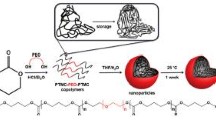Abstract
Purpose. The aim of this work was to develop PEGylated poly(alkylcyanoacrylate) nanoparticles from a novel methoxypolyethyleneglycol cyanoacrylate-co-hexadecyl cyanoacrylate copolymer.
Methods. PEGylated and non-PEGylated nanoparticles were formed by nanoprecipitation or by emulsion/solvent evaporation. Nanoparticles size, zeta potential and surface hydrophobicity were investigated. Surface chemical composition was determined by X-ray photoelectron spectroscopy. Nanoparticle morphology was investigated by transmission electron microscopy after freeze-fracture. Nanoparticles cytotoxicity was assayed in vitro, onto mouse peritoneal macrophages. Cell viability was determined through cell mitochondrial activity, by a tetrazolium-based colorimetric method (MTT test). Finally, the degradation of PEGylated and non-PEGylated poly(hexadecyl cyanoacrylate) nanoparticles was followed spectrophotometrically during incubation of nanoparticles in fetal calf serum.
Results. Monodisperse nanoparticles with a mean diameter ranging between 100 and 200 nm were obtained using nanoprecipitation or emulsion/solvent evaporation as preparation procedures. A complete physico-chemical characterization, including surface chemical analysis, allowed to confirm the formation of PEG-coated nanoparticles. The PEGylation of the cyanoacrylate polymer showed reduced cytotoxicity towards mouse peritoneal macrophages. Furthermore, the presence of the PEG segment increased the degradability of the poly(hexadecyl cyanoacrylate) polymer in presence of calf serum.
Conclusions. We succeeded to prepare PEGylated nanoparticles from a novel poly(methoxypolyethyleneglycol cyanoacrylate-co-hexadecyl cyanoacrylate) by two different techniques. Physico-chemical characterization showed the formation of a PEG coating layer. Low cytoxicity and enhanced degradation were also shown.
Similar content being viewed by others
REFERENCES
S. Stolnik, L. Illum, and S. S. Davis. Long circulating microparticulate drug carriers. Adv. Drug Del. Rev. 16:195–214 (1995).
G. Storm, S. O. Belliot, T. Daemen, and D. D. Lasic. Surface modification of nanoparticles to oppose uptake by the mononuclear phagocyte system. Adv. Drug Del. Rev. 17:31–48 (1995).
R. Gref, Y. Minamitake, M. T. Peracchia, and R. Langer. PEG-coated biodegradable nanospheres for intravenous drug administration. In S. Cohen, and H. Bernstein (eds.), Microparticulate systems for the delivery of proteins and vaccines, Marcel Dekker Inc., New York, 1996, pp. 279–306.
T. M. Allen. Long-circulating (sterically stabilized liposomes for targeted drug delivery. Trends in Pharm. Sci. 15:215–220 (1994).
S. J. Douglas, S. S. Davis, and L. Illum. Biodistribution of poly(isobutylcyanoacrylate) nanoparticles in rabbits. Int. J. Pharm. 34:145–152 (1986).
R. Gref, Y. Minamitake, M. T. Peracchia, V. Trubetskoy, V. Torchilin, and R. Langer. Biodegradable long-circulating polymeric nanospheres. Science 263:1600–1603 (1994).
D. Bazile, C. Prud'homme, M. T. Bassoullet, M. Marlard, G. Spenlehauer, and M. Veillard. Stealth MePEG-PLA nanoparticles avoid uptake by the Mononuclear Phagocyte System. J. Pharm. Sci. 84:493–498 (1995).
J. M. Harris. PEG Chemistry: biotechnical and biomedical Plenum Press, New York, 1992.
W. W. L. Wu, and I. Piirma. Synthesis and characterization of amphiphatic poly(methylmethacrylate)-b-poly(ethylene oxide) diblock copolymers. Polym. Bull. 31:531–538 (1993).
M. T. Peracchia, R. Gref, Y. Minamitake, A. Domb, and R. Langer. PEG-coated injectable nanospheres prepared from amphiphilic diblock and multiblock copolymers: investigation of drug encapsulation and release characteristics. J. Controlled Rel. 46:223–231 (1997).
M. T. Peracchia, C. Vauthier, F. Puisieux, and P. Couvreur. Development of sterically stabilized poly(isobutylcyanoacrylate) nanoparticles by chemical coupling of poly(ethylene glycol). J. Biomed. Mat. Res. 34:317–326 (1997).
Y. K. Choi, Y. H. Bae, and S. W. Kim. Block copolymer nanoparticles of ethylene oxide and isobutyl cyanoacrylate. Macromolecules. 28:8419–8421 (1995).
M. Miura, F. Akutsu, H. Ito, and K. Nagakubo. Graft copolymerization by macrozwitterion mechanism. J. Polym. Sci.: Polym. Chem. Ed. 17:1565–1568 (1979).
E. F. Donnelly, D. S. Johnston, D. C. Pepper, and D. J. Dunn. Ionic and zwitterionic polymerisation of n-alkyl 2-cyanoacrylates. Polym. Lett. Edn. 15:399–405 (1977).
M. T. Peracchia, D. Desmaële, P. Couvreur, and J. D'Angelo. Synthesis of a novel poly(MePEGcyanoacrylate-co-alkylcyanoa-crylate) amphiphilic copolymer for nanoparticles technology. Macromolecules. 30:846–851 (1997).
H. Fessi, F. Puisieux, J. Ph. Devissaguet, N. Ammoury, and S. Benita. Nanocapsule formation by interfacial polymer deposition following solvent displacement. Int. J. Pharm. 55:R1–R4 (1989).
R. Gurny, N. A. Peppas, D. D. Harrington, and G. S. Banker. Development of biodegradable and injectable latices for controlled release of potent drugs. Drug Develop. Ind. Pharm. 7:1–25 (1981).
A. Brindley, M. C. Davies, R. A. P. Lynn, S. S. Davies, J. Hearn, and J. F. Watts. The surface characterization of model charged and sterically stabilized polymer colloids by SSIMS and XPS. Polymer. 33:1112–1115 (1992).
D. Sgouras and R. Duncan. Methods for the evaluation of biocompatibility of soluble synthetic polymers which have potential for biomedical use: 1—Use of the tetrazolium-based colorimetric assay (MTT) as a preliminary screen for evaluation of in vitro cytotoxicity. J. Mater. Sci.-Mater. M. 1:61–68 (1990).
R. H. Müller, C. Lherm, J. Herbort, and P. Couvreur. In vitro model for the degradation of alkylcyanoacylate nanoparticles. Biomaterials. 11:590–595 (1990).
V. Lenaerts, P. Couvreur, D. Christiaens-Leyh, E. Joiris, and M. Roland. Degradation of poly(isobutylcyanoacrylate) nanoparticles. Biomaterials. 5:65–68 (1984).
Author information
Authors and Affiliations
Rights and permissions
About this article
Cite this article
Peracchia, M.T., Vauthier, C., Desmaële, D. et al. Pegylated Nanoparticles from a Novel Methoxypolyethylene Glycol Cyanoacrylate-Hexadecyl Cyanoacrylate Amphiphilic Copolymer. Pharm Res 15, 550–556 (1998). https://doi.org/10.1023/A:1011973625803
Issue Date:
DOI: https://doi.org/10.1023/A:1011973625803



